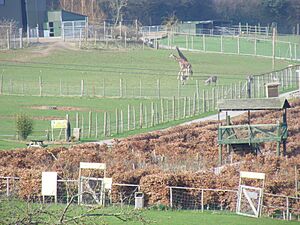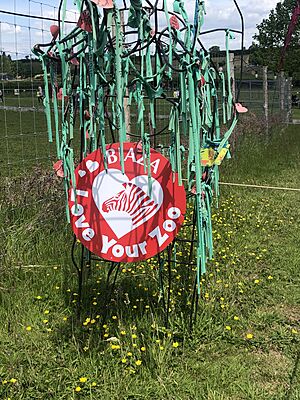Noah's Ark Zoo Farm facts for kids

Noah's Ark Zoo Farm Logo
|
|
 |
|
| Date opened | 1998–1999 |
|---|---|
| Location | Wraxall, North Somerset, United Kingdom |
| Land area | 100 acres (40 ha) |
| Coordinates | 51°27′15″N 2°44′24″W / 51.4541°N 2.7401°W |
| Annual visitors | 170,000 |
Noah's Ark Zoo Farm is a huge zoo, about 100 acres (40 ha) big, located on a working farm in Wraxall, North Somerset, England. It's about 6 miles (9.7 km) west of Bristol. This amazing place is known for having the largest home for elephants in northern Europe!
Contents
History of Noah's Ark Zoo Farm
How the Zoo Started
Noah's Ark Zoo Farm was created by Anthony Bush. He grew up on a farm in Wiltshire. In 1960, he started farming at Moat House Farm near Bristol. He raised dairy cows there. In 1962, he married Christina James, an art teacher. They had four children together. Anthony was very interested in helping farmers protect wildlife. He even started a group for this in 1980.
In 1995, the Bush family bought Moat House Farm. They decided to change things up. They sold their cows and started growing crops and raising sheep. Anthony then had an idea to create a "Noah's Ark" themed park. In 1998, they built a barn, a café, restrooms, and a play area for kids. The park first opened for a trial in August 1998 and then officially in 1999.
Growing the Animal Collection
When it first opened, Noah's Ark Zoo Farm had farm animals and small pets. Soon, they added more exotic animals like alpacas and llamas. Over time, the zoo grew to include exciting animals such as tigers, African lions, white rhinos, siamang gibbons, and ring-tailed lemurs. In April 2009, people even watched the live birth of a baby Brazilian tapir on the zoo's webcam!
The zoo also has a giant hedge maze. It was planted in 2003 and is 3.38 kilometres (2.10 mi) long. This makes it the longest maze of its kind in the UK!
Becoming a Charity
In 2009, Noah's Ark Zoo Farm faced some challenges regarding its animal care and membership with BIAZA (British and Irish Association of Zoos and Aquariums). The zoo worked hard to meet new, stricter rules. They had independent veterinarians check on the animals every six months. Because they followed these rules, the zoo got its BIAZA membership back in 2018.
After these events, Anthony Bush's son, Larry, became the managing director in 2019. He started the process for the zoo to become a charity. This was a big step! Larry explained that when visitors pay to enter, their money now directly helps with important animal conservation work. This work happens both in the UK and around the world. Noah's Ark Zoo Farm officially became a charity on April 5, 2023.
Conservation Efforts at Noah's Ark
Noah's Ark Zoo Farm is very involved in protecting endangered animals. In 2015, the zoo joined the European Endangered Species Programme (EEP). This program helps manage and protect species that are at risk.
Helping Endangered Species
The zoo takes part in several EEPs. These include programs for African Elephants, Spectacled Bears, Siamang Gibbons, and White-Headed Vultures. Noah's Ark also helps with European Studbooks for animals like the Cotton-Top Tamarin and the Asian Box Turtle. These studbooks keep track of animals to help with breeding programs.
Elephant Eden Sanctuary
The EEP for African Elephants at Noah's Ark is special. It's a "bachelor program," meaning only male elephants live there. This gives them a safe home while they wait for a chance to breed in other zoos.
In September 2012, the zoo started building a huge elephant sanctuary. It covers about 20 acres (8.1 ha)! The first elephant arrived in February 2014. The elephant home has a large indoor area, about 1,080 m2 (11,600 sq ft), where the elephants can sleep or stay dry. Outside, there's a 19.5 acres (7.9 ha) area with a 9 ft (2.7 m) heated swimming pool. This amazing project cost £1.8 million. It uses solar power, special heating systems, and collects rainwater. This helps the elephant home use almost all its own power. A farm next to the zoo even grows most of the food for the elephants!
Sustainable Zoo Practices
Noah's Ark Zoo Farm calls itself a "sustainable zoo." This means they try to be very friendly to the environment. They use wind turbines, special boilers, and solar panels. More than half of the energy they use is made right there at the zoo! They even have a Christmas tree recycling service. People in North Somerset can give their used Christmas trees to the zoo. The animals love playing with them!
Animal Exhibits and Habitats
Noah's Ark Zoo Farm has different areas where animals from specific parts of the world live.
Animals of Africa
The first animals in the African section arrived in 2005. These were two South African white rhinos. In 2006, a Giraffe House opened. Two African lions joined the Big Cat Sanctuary in 2010. The first African elephant came to Elephant Eden in 2014. By 2015, the zoo had four giraffes (two born at the zoo!), four lions, two African elephants, two white rhinos, two zebras, and a family of meerkats. Sadly, in 2020, a young zebra named Hope passed away after being scared by fireworks. In June 2021, an African elephant was fatally attacked by another elephant.
Animals of Asia
In 2009, Noah's Ark welcomed two Bengal tigers to their new 'Tiger Territory'. This area later became known as the 'Big Cat Sanctuary'. The Asian section at Noah's Ark is also home to yaks, water buffalo, and two Bactrian camels.
Primates at the Zoo
Noah's Ark is home to five different types of primates. These include Siamang Gibbons, black & white ruffed lemurs, ring tailed lemurs, marmosets, and cotton-top tamarins. Three of these primates (ruffed lemurs, tamarins, and gibbons) are listed as endangered or critically endangered. This means they are at high risk of disappearing from the wild. The primate section has been successful in breeding animals. A baby Siamang gibbon was born there recently! The gibbons moved to Noah's Ark in 2007 as part of the European Endangered Species Programme.
Reptile Residents
In July 2017, the zoo welcomed seven Aldabra giant tortoises. These huge tortoises were on loan from Nigel Marven. The design of the tortoise enclosure even won an award from BIAZA for being so well-designed!





